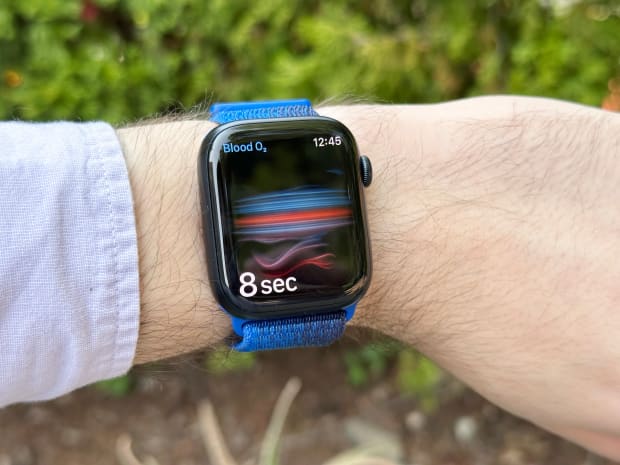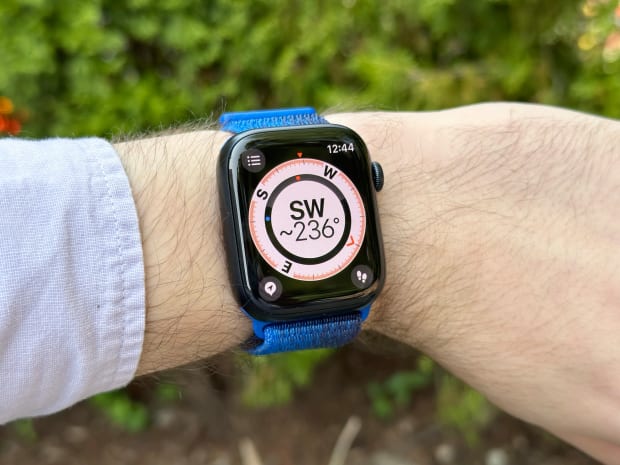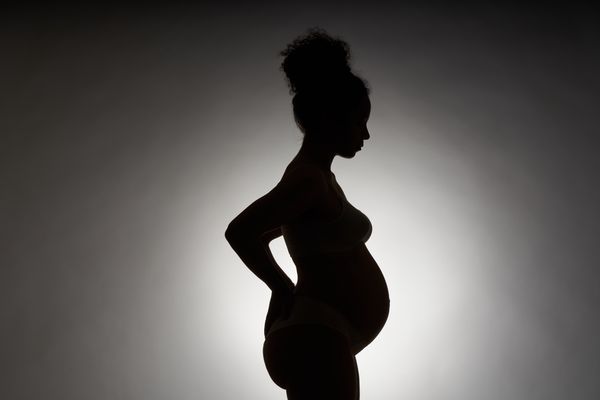Since its launch in 2014, Apple (AAPL) has continued to evolve the Apple Watch. It went from being an extension of the iPhone to a full fledged device with a gambit of health features. With updates rolled out each year, the enhancements have been both small and large.
For 2022, we have three new Apple Watches: The entry-level Apple Watch SE, the middle Apple Watch Series 8, and the ultra-rugged Apple Watch Ultra. I’ve already reviewed the best-in-value Apple Watch SE and now we turn focus to Series 8.
It's a pro-for-everyone unit with a larger always-on display, and offers some of Apple’s most advanced health features to date. The extravagant finishes tie a bow on the new model, from aluminum to stainless steel – and even a Hermes Edition.
If all this sounds familiar, it should since it was the formula for the Series 7. And with the clock striking eight, you get a new temperature sensor and crash detection. So let’s dive into the Series 8 and who it’s for.
- Apple Watch Series 8 41mm GPS in Midnight, Starlight, Silver or (PRODUCT) RED ($399; Amazon.com or Walmart.com)
- Apple Watch Series 8 45mm GPS in Midnight, Starlight, Silver or (PRODUCT) RED ($429; Amazon.com or Walmart.com)
- Apple Watch Series 8 41mm GPS + Cellular in Midnight, Starlight, Silver or (PRODUCT) RED ($499; Amazon.com or Walmart.com)
- Apple Watch Series 8 45mm GPS + Cellular in Midnight, Starlight, Silver or (PRODUCT) RED ($529; Amazon.com or Walmart.com)
The Arena Media Brands, LLC and respective content providers may receive compensation for some links to products and services on this website.
Apple Watch Series 8: An All-Screen Premium Watch
Much like the Series 7 before it, the Series 8 continues the trend of sleek and modern appeal. The 41mm or 45mm size looks appropriate on nearly any wrist – while the screens are larger than those of the Apple Watch SEs (or the Series 6 and earlier models), it still fits comfortably on most wrists. Petite women may prefer to opt for the 41mm size (as tested by my fellow colleague). During my own hands-on the 49mm Ultra is quite big, but a manageable size for most folks.
Display: 41mm or 45mm
The Series 8 excels as a “middle ground” option, and one that is suitable for most smartwatch users who want an always-on screen or all the health features. Its display is vibrant and packed with detail, and bright enough to use in direct sunlight or in a building with fluorescent lights. It’s been tough enough to battle through the New Jersey sun -- though as Springsteen suggests in “Blinded by the Light,” you probably shouldn’t stare directly into it -- and worked just swimmingly while in California during the heatwave.
Unique to the Series 8 is that the screen goes all the way to the edges and even curves (or rather, slopes) down the sides. With a quick glance, you can make out the number dials turning on a smartwatch even when not looking head-on. During my testing, I could look at it from an extremely off-angle view (while cycling or running), and still make out the watch face.
WatchOS 9 has introduced a bevy of new watch face samples that stretch your screen data right to the edge. I really like Modular and Astronomy which can transform the front. The former also lets you add compilations -- aka mini widgets -- to the screen for easy task completion. Customization is the name of the game when it comes to the digital display screen for the Apple Watch.
Material quality and colors
Apple offers the Series 8 in a few finishes -- the cheapest $399 models are made from aluminum and come in (PRODUCT) RED, Starlight, Silver, or Midnight.
I’ve been testing the Midnight, and it’s a very dark blue that in some lighting can appear as black. If you like to match product colors, the Midnight is the same shade that the MacBook Air with M2 or the iPhones come in. If you’re willing to spend more, you can also get it in stainless steel or a Hermes Band with a stainless steel watch.
The Apple Watch Series 8 has a durable aluminum build, and on the back of the watch, the latest sensor stack -- which is a part of the new S8 SiP -- sits as a piece of sapphire glass that rests on the top of my wrist. This sensor features can track a ton of health data, including:
- Heart Rate
- Electrocardiogram (ECG) by pressing your finger on the digital crown
- Blood Oxygen
- Skin temperature
The left side of the watch still contains a rectangular slit for the speaker, while the right side has the Digital Crown and a side button. The crown here can be used to select something by pushing, or turned up or down to scroll or zoom. It’s a really nice interface and I especially like the minute vibrations (aka haptics) built-in which give you feedback as you scroll.
Apple Watch Bands
The Series 8 is compatible with all previous Apple Watch Bands, assuming you have bands that match the same screen size. This is good news if you have a collection of bands and upgrade every so often. I’ve also been trying the new woven Nike sport loop bands, which are made from a nylon weave and have the “Just Do It” tagline right on the band. It’s a pretty similar design to the Pride Edition bands from earlier this year. It’s excellent for workouts as well as everyday use.
Skin Temperature and Other Health Features

Much like the Apple Watch Series 6 and Series 7, the Series 8 is the Apple smartwatch to get you if you want the health features. The Series 8 can track blood oxygen levels, measure your heart rate, and take an electrocardiogram on your wrist. Much like other watches and fitness trackers, it will also track steps, calories burned, exercise minutes, and workouts.
But there is a new feature added to the Series 8, specifically two sensors that track skin temperature. One of the sensors is clustered close to the wrist to get the temperature of your skin, and one located under the display to measure the environment. These work in tandem to ensure data accuracy, especially when environmental factors may have changed.
Establishing a Baseline
The skin temperature feature will work in the background to gather your baseline. Apple reports that working in tandem with the Health app, it can take at least five nights of sleep for it to learn your baseline and display the data. During my testing, it took six nights to establish a baseline, and now within the Health app I can view a graph showing high or low changes, though it doesn’t share that exact reading.
The general idea is that over time, being above or below this baseline should correlate with health fluctuations. Maybe it has to do with stress or with being ill, but it’s more of a long game here, and is similar to the way that the Oura Ring is designed.
Cycle Tracking
Cycle tracking is not new to the Apple Watch, as via the Health app you can input data to estimate a menstrual cycle and ovulation. Fitbit, among other apps, also offers a similar feature.
This new skin temperature sensor was designed to elevate the cycle tracking experience on the Apple Watch though. If you’re already using this feature, an Apple Watch Series 8 with the temperature sensor is intended to provide more data around your menstrual cycle and ovulation. Essentially, this smartwatch is aiming to track a biphasic shift, which correlates a temperature swing that matches with hormones changing.
As with any general purpose body metric, Apple is clear that this isn’t predicting the future (either ovulation or period occurrence), but rather providing historical data to help develop your personal body insights. Apple notes that with sleep and ovulation tracking enabled, it will take about two menstrual cycles to get baseline readings on target. Combined with the added data from skin temperature, it should start making predictions as to when your period might start by looking back at your menstrual cycle data.
I have not been able to test the ovulation features, obviously, so I’m not going to provide an analysis here. Education around physical and mental health is a worthy cause, but it’s an understandable concern when big tech companies have access to such personal data.
This comes at a time when women’s body rights have been under relentless political scrutiny and protections repealed. Apple has taken a stance that the company remains committed to privacy, and that this data is locked on your Apple Watch and iPhone. Either device would need your authentication since it’s encrypted (preferably a two-step authentication unless you’ve disabled this function), to access this information.
For more information on Apple’s data privacy, you can learn more here.
Medication Reminders
My favorite Health feature currently on the Apple Watch isn’t exclusive to the Series 8, and is available through any Apple Watch running watchOS 9. You can use it to track your medications and get reminders to take them.
How it works: You’ll scan the pill bottle in, pick an icon for it, and then set how often you take it. You’ll then get a reminder on your iPhone and the watch to ensure you’re taking it, and log it. And if the Health app detects any possible interferences between medicines (or even medicine and alcohol), it will alert you.
Crash Sensors
And finally, Apple has included some additional gyroscopes and accelerometers to detect a collision. Obviously, I didn’t test this as I didn’t crash a car. According to Apple, the Apple Watch’s sensors and microphones have been trained to detect movements and sound associated with a crash. This is the same auto crash feature now baked into the Apple Watch SE, iPhone 14, iPhone 14 Pro and iPhone 14 Pro Max.
Suffice to say it’s nice to have here, but something I hope no user ever has to call upon. In the event it does occur, the service can automatically connect you with the authorities and alert your emergency contacts.
Finally, a Low Power Mode and Fast Charging

With watchOS 9 Apple finally delivered a Low Power Mode to the Apple Watch Series 8 as well as the Series 4, 5, 6, 7 and the original Apple Watch SE. So it's not a reason just to run out and buy a Series 8, remember to update to watchOS 9.
How it works: Swipe up from the bottom of the screen to the battery menu and tap “Low Power Mode.” It will shut off the always-on display and some background readings, and will slow down notification delivery. You’ll still get all other functionality including Activity Tracking. Apple claims that Low Power mode stretches battery life for Series 8 to 36 hours.
On average, I’ve had the Series 8 last for a full day, but with Sleep Tracking I ended up charging it before going to bed or right after I wake for about twenty minutes. With low-power mode, I’ve had the same charge working for about two full days so far. I’ll continue to update the review on this as I keep testing it.
The other thing that makes the Series 8 so great, as it did for the Series 7, is that it supports Fast Charging. So with the charging puck that comes in the box and a 20-watt adapter like this one from Anker, you can fast charge the Apple Watch. In my experience, it takes about 20 minutes for 50%, and 35 minutes to reach 80%. That’s quite reasonable, and fast charging paired with low-power mode effectively solves the battery life issue.
watchOS9 updates
It also doesn’t hurt that watchOS 9, the most recent software release, is pretty darn efficient and feature packed. You can see my full thoughts on watchOS 9 here, but it really makes the Series 8 seamless. Like the Apple Watch SE and the Apple Watch Ultra, the Series 8 gets the upgraded compass app which can track your hike, and at the push of a button help you retrace your steps.
You also have larger buttons within applications and an improved on-screen keyboard that really take advantage of the larger display here. And if you have a Series 7 or even a Series 6, watchOS 9 is available for those devices as well.
Is the Apple Watch Series 8 Worth it?

In our opinion, yes, the Apple Watch Series 8 is a great Apple Watch choice, and is designed for most users that are looking for health and fitness tracking, an always-on display, and upgraded battery life.
The Series 8 improves upon the Series 7 with small tweaks, namely with a temperature sensor and crash detection. But if either of those new features appeals to you, and peace of mind certainly does to me, it could be worth an upgrade for you.
Upgrading to the Apple Watch Series 8 makes more sense for folks with an older model like the Series 4, 5, or 6, since you’ll benefit from a bevy of new features like a larger screen, much better performance and battery life, with several new health features.
And if you don’t have an Apple Watch yet, and want a fully featured one, the Series 8 fits the bill. But if you can do without an always-on display or every health feature, the Apple Watch SE is a lot cheaper at $249 and brings a ton of value.
Then there is also the question of Apple Watch Ultra, which increases the durability, stretches the battery life, adds in a new button, and offers a larger display. That starts at $800 and it looks super cool, kind of like a lovely chunky watch for a superhero, but I’ll have to come back to that after I’ve tested it.
And lastly, if you are upgrading it’s good to see what the trade-in value of your current Apple Watch is through a service like Decluttr.
- Apple Watch Series 8 41mm GPS in Midnight, Starlight, Silver or (PRODUCT) RED ($399; Amazon.com or Walmart.com)
- Apple Watch Series 8 45mm GPS in Midnight, Starlight, Silver or (PRODUCT) RED ($429; Amazon.com or Walmart.com)
- Apple Watch Series 8 41mm GPS + Cellular in Midnight, Starlight, Silver or (PRODUCT) RED ($499; Amazon.com or Walmart.com)
- Apple Watch Series 8 45mm GPS + Cellular in Midnight, Starlight, Silver or (PRODUCT) RED ($529; Amazon.com or Walmart.com)
How the Apple Watch Series 8 Compares to the SE and Ultra
Apple Watch FAQ
How does the Apple Watch Series 8 compare to the Apple Watch Ultra?
There are a few key differences between the Apple Watch Series 8 and the Apple Watch Ultra, including price, screen size, durability, and battery life.
Price: The Series 8 starts at $399, while the Ultra starts at $800.
Screen size: You can also pick between two sizes for Apple Watch Series 8 – 41mm or 45mm – along with GPS or GPS with Cellular connectivity. The Apple Watch Ultra comes in a single 49mm Titanium size with GPS + Cellular out of the box.
Health features: Both of them offer the same health and activity features— heart rate, ECG, blood oxygen, and wrist temperature— along with them both being powered by the S8 SiP and running watchOS 9.
Durability: The Apple Watch Ultra is more durable and can endure more extreme temperatures, while it also has longer battery life at 30+ hours with low power mode off and over 60 hours with it on.
If I have a Series 7, should I upgrade?
Realistically, most people with an Apple Watch Series 7 can skip this upgrade cycle. If you really want wrist temperature readings or crash detection, the Series 8 does offer those. But aside from those, it's a very similar experience.
What types of bands work with the Apple Watch Series 8?
The Apple Watch Series 8 still works with all previous Apple Watch Bands since it uses the same design. The 41mm size will work with 38mm, 40mm, and 41mm band sizes. The 45mm will support 40, 42, and 44mm sizes. This way you can bring your brand collection with you as you get a newer watch.
Fun fact: the Apple Watch SE will also support all band sizes while the single model Apple Watch Ultra will work with 45mm bands.
Prices are accurate and items in stock at time of publishing.







